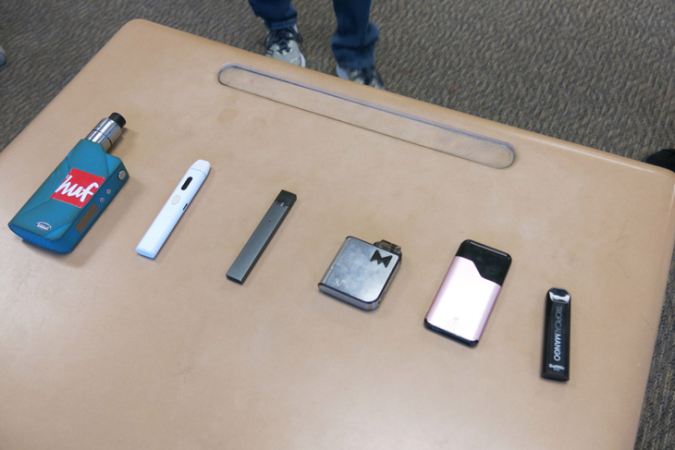Health risks are scaring some teen vapers into considering quitting
The challenge: Money and other resources are geared more to helping smokers, not vapers

Starting to vape is easy, but quitting a nicotine habit can be tough, teens are finding. Some vaping-cessation programs have begun to reach out to teens where they live — on their phones.
Mixmike/E+/Getty Images
It all started at the mall when a friend offered Beth a puff from a Juul e-cigarette. At the time, the Denver, Colo.-area student was in middle school.
“It was kind of peer pressure,” the now 15-year-old recalls. “I started inhaling it,” she says. “I suddenly was, like, wow, I really think that I need this — even though I don’t.” (The teen has asked that her last name not be used because she has not yet told her parents that she vapes.)
Soon, Beth had a Juul of her own. She was vaping half a pod of e-liquid a day. That much provides the nicotine equal to half a pack of conventional cigarettes. The girl used other brands, too — a Suorin, a Smok Novo and a modified device, which gives users custom vaping options.
“When you wake up in the morning, you’re just like, ‘Oh, I need to hit my thing. Where is it?’” Beth says. “’You can’t really get it off your mind unless you distract yourself.’”
Eventually, the teen tried to quit so that her mom wouldn’t find out. But it’s been hard, she says. Her school doesn’t have the resources to help her.
Of 37 states surveyed in 2017, Colorado had the highest rate of teen vaping. That’s according to the Centers for Disease Control and Prevention, or CDC. This U.S. health agency is based in Atlanta, Ga. One in four of the Colorado students who were surveyed said they currently use an electronic vapor product — double the national average. Beth guesses that half of her classmates vape regularly. Her school does offer some tobacco-prevention education. Still, she says, teens could use a lot more support to help them to quit.
It may not seem obvious, but e-cigarettes are considered a “tobacco product.” That’s because most e-cigs vaporize a liquid that contains nicotine, a natural drug. That nicotine, an addictive stimulant, comes from tobacco leaves.
Beth says she managed to stop vaping a few weeks ago. She was motivated by news stories of young people falling ill. When one of her own friends got sick, that was a turning point.
On Nov. 7, the CDC reported it was investigating 2,051 lung injuries associated with vaping across 49 states (all but Alaska), including 39 deaths. One day later, CDC announced it had data that seem to confirm a suspicion about what may underlie many of the severe lung injuries seen this year in U.S. vapers. It found vitamin E acetate in fluid from the lungs of all 29 patients from which it had received samples.
Vitamin E acetate is widely used as a dietary supplement. It also is used as a diluting and thickening ingredient in some vaping products that contain THC, the chemical in marijuana that causes a “high.” Most of the tested patients reported they had vaped liquids containing THC. Although vitamin E acetate is considered safe when used in skin creams or as a dietary supplement, research indicates that it could be harmful when inhaled.
An early online description of the test data on the vitamin E acetate appears in Morbidity and Mortality Weekly Report.
“We are in a better place than we were two weeks ago, in terms of having [this] one very strong culprit,” said Anne Schuchat during a Nov. 8 news briefing. She’s CDC’s principal deputy director, based in Atlanta. Still, she added, no one yet knows precisely how this substance might harm the lungs. What’s more, she said it’s possible that this substance may not be acting alone in causing the lung injuries.
Beth says that before learning of the lung injuries and other vaping risks, “I didn’t really take it super seriously.” But then, she says, “I was like, oh, what are the chances that that’s going to happen to me? And then my friend actually almost had his lung collapse.” She says he was coughing up blood and mucus. “I just couldn’t do it anymore,” Beth decided. “It’s not worth it.”
Little money to help teens stop vaping
A new government survey shows more than one in four U.S. high school students have used an e-cigarette in the past 30 days. Among middle-school students, the rate was 10.5 percent. People who work to keep the public healthy say that funding for anti-tobacco efforts is inadequate.
States receive yearly payments from tobacco companies as part of a 1998 lawsuit settlement. But those states are not following CDC guidance on setting aside large chunks of that money to help tobacco users or to prevent others from starting. States can spend that money on whatever they want.
Cigarette taxes have been one traditional source of funding for anti-smoking programs. But with fewer people smoking cigarettes, that source of money has been shrinking. Colorado’s health department says cigarette sales in its state have declined by 41 percent (two-fifths) since 1990. And in more than half of U.S. states, including Colorado, vapes aren’t taxed — at least not yet.
“It is daunting,” says Alison Reidmohr. She is a tobacco-communications specialist for Colorado’s Department of Health and Public Environment in Denver. “We’ve got more problems than we’ve seen before and fewer resources [money] with which to deal with them.”
Some 27,000 Colorado high schoolers report vaping more than 10 days a month, Reidmohr says. “More people are using more nicotine products. Our young people are facing an epidemic of vaping. We’re not funded to deal with vaping products.”
Colorado spends nearly $24 million a year on tobacco prevention. Still, a recent report from the Campaign for Tobacco Free-Kids finds that this is less than half of what the CDC recommends, and one-fifth of what the tobacco industry spends on marketing in the state.
“Really, we have almost nothing in terms of treatment for these kids,” says Christian Thurstone. He’s a physician who runs drug-abuse prevention programs for teens in Denver. Teens have gotten addicted to nicotine so fast, he says, that it’s uncharted territory.
There are websites, hotlines, therapists and coaches to help kids manage nicotine cravings. However, those efforts were all designed to manage cigarettes, Thurstone says. He has turned up no studies aimed at helping adolescents quit vaping.
“We need some research, fast,” he says.
A spokesman for the popular Juul brand says no young person or non-nicotine user should ever try Juul. But he didn’t say how minors who’ve started to use the product might quit.
Most teens just need to decide they’re not going to use anymore, says Gregory Conley. This New Jersey attorney also serves as president of the American Vaping Association, which is based in Stamford, Conn. “It’s only a small sliver that may actually need some assistance to get off the products,” he says.
Colorado’s health department disputes that. It estimates that one in 10 of the state’s high schoolers vape nicotine more than 10 days a month.
Coaching is available to some who want it
In July, National Jewish Health in Denver launched a program aimed at helping teens give up nicotine, vaping and other tobacco products. In a large open office, coaches answer calls. “Thank you for calling My Life My Quit,” one says. “Congratulations on making the decision to quit.” The program — which uses a traditional help line, chats and live coaching — has seen a sharp surge in sign-ups in the past month.

My Life My Quit serves Colorado. It also is available in 11 other states — Iowa, Massachusetts, Michigan, Montana, Nevada, North Dakota, New Hampshire, Ohio, Pennsylvania, Utah and Wyoming. Thomas Ylioja leads the Health Initiatives program at National Jewish Health. Data show that a little more than one in eight U.S. high school seniors vape daily, he says.
Teens are “telling us they can feel their lungs burning when they’re using these products,” Ylioja says. “They’re telling us that they can’t exercise the same way they used to before. They’re telling us that they can’t give up these products just on their own, that they need help.”
The program has lately added coaching by text, he says. After all, he says, that’s how many teens like to communicate.
In his office, Ylioja reads from a printout of text conversations between teens and coaches. “I’m 16 years old,” one student writes. “I’m super addicted to vaping. I can’t seem to quit when I don’t have it. That’s all I think about.”
“‘My family is worried and all the stories about people getting sick,’” said another text. “‘I don’t know if it’s really bad to vape . . . They could be rare occasions, but I’m worried about it.’”
Nichole Lopez is one of the program’s coaches. Teens often think they’re invincible, she says. But news of young people getting sick is suddenly making the dangers seem real. “It’s freaking them out,” she says. “I had somebody say, ‘I just don’t want to die, so I need to quit.’”
The Truth Initiative is a nonprofit public-health group aimed at helping young people quit smoking. Lately, it has expanded its resources to include a program focused on e-cigarettes. Its free text-messaging program is “tailored by age group.” It offers teens and young adults appropriate recommendations about quitting. It also offers resources for parents looking to help children who are vaping and may want to quit.

Don Daniels directs the tobacco-education program at Chatfield High in Littleton, Colo. He says that he’s begun sensing what he thinks could be a dramatic change in teen attitudes about e-cigs.
Reports of people being “truly sick and dying from these devices is enough for young people to make a decision that’s going to benefit their health,” Daniels says. “They’re savvy. This is a smart generation and they’re thoughtful,” he adds. “They have the ability to make good choices.”
Chatfield senior Mia Norrid is a swimmer who doesn’t vape. But her mom posted a story about vaping-linked illnesses on Facebook and tagged her daughter as a nudge to speak up.
“I think she tagged me,” the teen says, “so I could let my friends know about it, because a lot of my friends do it.”
NOTE: This story was updated at 4:45 p.m. to include the new CDC announcement on vitamin E acetate.
This story is part of a reporting partnership that includes Colorado Public Radio, NPR and Kaiser Health News.







